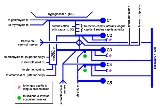
Cervical plexus
Encyclopedia
The cervical plexus is a plexus
of the ventral rami of the first four cervical spinal nerves which are located from C1 to C4 cervical segment in the neck
. They are located laterally to the transverse processes between prevertebral muscles from the medial side and vertebral (m.scalenus, m.levator scapulae, m.splenius cervicis) from lateral side. There is anastomosis with accessory nerve
, hypoglossal nerve
and sympathetic trunk
.
It is located in the neck
, deep to sternocleidomastoid. Nerves formed from the cervical plexus innervate the back of the head
, as well as some neck muscles. The branches of the cervical plexus emerge from the posterior triangle at the nerve point, a point which lies midway on the posterior border of the Sternocleidomastoid.
and muscular.
Plexus
A plexus is a part of nervous system. Plexus has a slightly different definition in vertebrates and in invertebrates.- In vertebrates :In vertebrates, a plexus is an area where nerves branch and rejoin. The electrical signals do not mix; rather, the fibres travel together with their electrical...
of the ventral rami of the first four cervical spinal nerves which are located from C1 to C4 cervical segment in the neck
Neck
The neck is the part of the body, on many terrestrial or secondarily aquatic vertebrates, that distinguishes the head from the torso or trunk. The adjective signifying "of the neck" is cervical .-Boner anatomy: The cervical spine:The cervical portion of the human spine comprises seven boney...
. They are located laterally to the transverse processes between prevertebral muscles from the medial side and vertebral (m.scalenus, m.levator scapulae, m.splenius cervicis) from lateral side. There is anastomosis with accessory nerve
Accessory nerve
In anatomy, the accessory nerve is a nerve that controls specific muscles of the shoulder and neck. As part of it was formerly believed to originate in the brain, it is considered a cranial nerve...
, hypoglossal nerve
Hypoglossal nerve
The hypoglossal nerve is the twelfth cranial nerve , leading to the tongue. The nerve arises from the hypoglossal nucleus and emerges from the medulla oblongata in the preolivary sulcus separating the olive and the pyramid. It then passes through the hypoglossal canal...
and sympathetic trunk
Sympathetic trunk
The sympathetic trunks are a paired bundle of nerve fibers that run from the base of the skull to the coccyx.-Structure:...
.
It is located in the neck
Neck
The neck is the part of the body, on many terrestrial or secondarily aquatic vertebrates, that distinguishes the head from the torso or trunk. The adjective signifying "of the neck" is cervical .-Boner anatomy: The cervical spine:The cervical portion of the human spine comprises seven boney...
, deep to sternocleidomastoid. Nerves formed from the cervical plexus innervate the back of the head
Head
In anatomy, the head of an animal is the rostral part that usually comprises the brain, eyes, ears, nose and mouth . Some very simple animals may not have a head, but many bilaterally symmetric forms do....
, as well as some neck muscles. The branches of the cervical plexus emerge from the posterior triangle at the nerve point, a point which lies midway on the posterior border of the Sternocleidomastoid.
Branches
The cervical plexus has two types of branches: cutaneousCutaneous innervation
Cutaneous innervation refers to the area of the skin which is supplied by a specific cutaneous nerve.Dermatomes are similar; however, a dermatome only specifies the area served by a spinal nerve...
and muscular.
- Cutaneous (4 branches):
- Lesser occipital nerveLesser occipital nerveThe lesser occipital nerve or small occipital nerve is a cutaneous spinal nerve arising between the second and third cervical vertebrae, along with the greater occipital nerve...
- innervates lateral part of occipitalOccipitalThe word occipital, in zoology, pertains to the occiput .Occipital is a descriptor for several areas of animal & human anatomy.*External occipital protuberance* Internal occipital crest* Greater occipital nerve...
region (C2 ONLY) - Great auricular nerve - innervates skin near conchaConchaConcha can refer to:* The bowl-shaped part of the pinna nearest the ear canal* Concha or Concho, a round decorative piece of metal seen on a western saddle and other horse equipment descended from the Spanish tradition....
auricle and external acoustic meatus (C2&C3) - Transverse cervical nerveTransverse cervical nerveThe transverse cervical nerve arises from the second and third cervical nerves, turns around the posterior border of the sternocleidomastoideus about its middle, and, passing obliquely forward beneath the external jugular vein to the anterior border of the muscle, it perforates the deep cervical...
- innervates anterior region of neck (C2&C3) - Supraclavicular nervesSupraclavicular nervesThe supraclavicular nerves arise from the third and fourth cervical nerves; they emerge beneath the posterior border of the Sternocleidomastoideus, and descend in the posterior triangle of the neck beneath the platysma and deep cervical fascia.-Branches:Near the clavicle they perforate the fascia...
- innervate region of supraspinatus, shoulderShoulderThe human shoulder is made up of three bones: the clavicle , the scapula , and the humerus as well as associated muscles, ligaments and tendons. The articulations between the bones of the shoulder make up the shoulder joints. The major joint of the shoulder is the glenohumeral joint, which...
, and upper thoracic region (C3,C4)
- Lesser occipital nerve
- Muscular
- Ansa cervicalisAnsa cervicalisThe ansa cervicalis is a loop of nerves that are part of the cervical plexus. It lies superficial to the internal jugular vein in the carotid sheath....
(loop formed from C1-C3), etc. (geniohyoid (C1 only), thyrohyoid (C1 only), sternothyroid, sternohyoid, omohyoid) - Phrenic (C3-C5 (primarily C4))-innervates diaphragm and the pericardium
- Segmental branches (C1-C4)- innervates anterior and middle scalenes
- Ansa cervicalis

